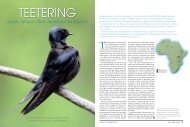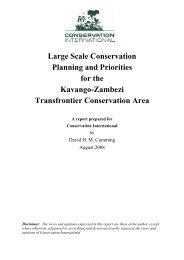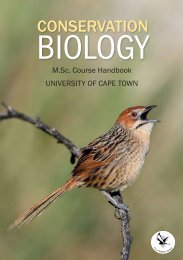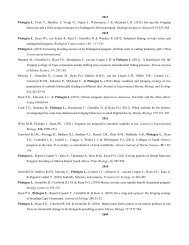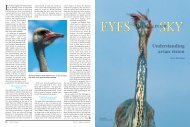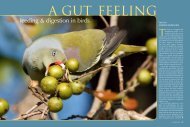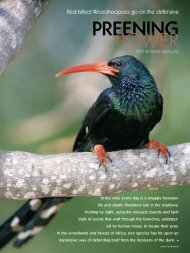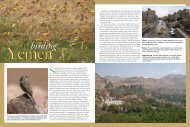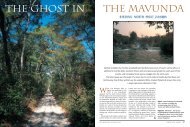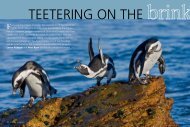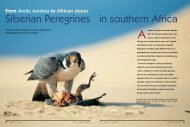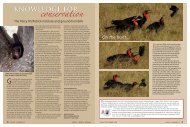Index of /depts/fitzpatrick/docs - Percy FitzPatrick Institute of African ...
Index of /depts/fitzpatrick/docs - Percy FitzPatrick Institute of African ...
Index of /depts/fitzpatrick/docs - Percy FitzPatrick Institute of African ...
Create successful ePaper yourself
Turn your PDF publications into a flip-book with our unique Google optimized e-Paper software.
conductors, where they are unlikely to cause problems. One <strong>of</strong>these platforms has already been used by a pair <strong>of</strong> MartialEagles, confirming this as a tenable management andmitigation option. An initial study <strong>of</strong> nest distributions suggeststhat large eagles in the Karoo are insensitive to many microandmacro-scale measures <strong>of</strong> habitat quality, but maysomehow benefit from the influences <strong>of</strong> game farming.Low-key, long-term demographic studies <strong>of</strong> raptorpopulations – Peregrines, Rock Kestrels, Black Sparrowhawks- on the Cape Peninsula have continued, with an emphasis oncolour-ringing adults and young in each population, andmonitoring the occupancy <strong>of</strong> territories and the performance <strong>of</strong>individuals in relation to habitat quality. As by-products <strong>of</strong> theseprojects, a study <strong>of</strong> genetic structure in southern <strong>African</strong>Peregrine populations is underway, in collaboration with BettineJansen van Vuuren at Stellenbosch University, and a studycombining the results <strong>of</strong> some recent genetics work with acomprehensive set <strong>of</strong> morphometric and plumage data hasshown that southern Africa’s Rock Kestrel Falco tinnunculusrupicolus is almost certainly a distinct, regionally endemicspecies and not a subspecies <strong>of</strong> the Common Kestrel F.tinnunculus.Two entirely new projects were started during the reviewperiod. The first looks at Barn Owls as bio-control agents <strong>of</strong>rodents in cereal croplands, and is based on farms in localwheat-growing areas where some landowners are usingcustom-built nest boxes to attract owls onto their properties.Evidently, the owls curb the populations and activities <strong>of</strong> gerbilsand other rodent pests. The study will examine exactly how,and how efficiently, the owls control rodent outbreaks, and limitcrop losses and the need for farmers to resort to expensive andenvironmentally harmful rodenticides. A second new study –the Goudini Fish Eagle Project - investigates pesticidecontamination in raptor populations along the upper and centralreaches <strong>of</strong> the Breede River, as a measure <strong>of</strong> the extent towhich environments in this heavily cultivated valley arepermeated and compromised by agrochemicals. The studyfocuses on the Fish Eagle and Black Sparrowhawk populationsin the valley, as representatives <strong>of</strong> piscivorous and bird-eatingconsumers respectively.Highlights• Integration <strong>of</strong> the Black Harrier Project into C.A.P.E., andsecuring three years <strong>of</strong> funding for the project from theCEPF.• Location and monitoring <strong>of</strong> over 80 large eagle nests onEskom transmission lines in the Karoo.• Use <strong>of</strong> morphometric and plumage data to confirm theRock Kestrel as a distinct species – Falco rupicolus?StudentsOdette Curtis (MSc); Land transformation and the conservationstatus <strong>of</strong> the Black Harrier: does habitat fragmentationinfluence the distribution and performance <strong>of</strong> breeding pairs?Leigh Potter (MSc Conservation Biology); Birds as bothacademic and agricultural tools: investigating the Barn Owlas a model <strong>of</strong> life history theory and an agent <strong>of</strong> bio-controlAdam Welz (BSc Hons); Raptors as indicators <strong>of</strong> agrochemicalcontamination <strong>of</strong> the Breede River Basin, South AfricaKath Potgieter (BSc Hons); Small mammal abundance anddiversity in pristine, modified and transformed habitats in theFynbos Biome, South Africa: implications for floralconservation?Electric Eagles – finding solutions to the problem <strong>of</strong> eagles on pylons.Photo: Andrew JenkinsLecturesMembers <strong>of</strong> the WCRRP team gave at least 10 talks tomembership-based societies during the review period.AcknowledgementsThe Cape Bird Club has provided generous financialsupport for the WCRRP over the last three years. The BlackHarrier Project is funded by the CEPF, the Electric EagleProject is conducted on contract to Eskom TSI Division, theGoudini Fish Eagle Project is funded by Goudini WineCellar, and raptor research on the Cape Peninsula issponsored by Peregrine Properties and MvelaphandaProperties. We would like to thanks Chris van Rooyen (<strong>of</strong>the Eskom/EWT Strategic Partnership) for facilitating theElectric Eagle Project so effectively, Nico Dippenaar <strong>of</strong>Goudini Wine Cellar for his support <strong>of</strong> our work on theBreede River, and Ann Koeslag and Ge<strong>of</strong>f Seekings <strong>of</strong> theCape Bird Club for their help with monitoring sparrowhawknests on the Cape Peninsula.20 <strong>Percy</strong> <strong>FitzPatrick</strong> <strong>Institute</strong> Annual Report: July 2002 - June 2003



